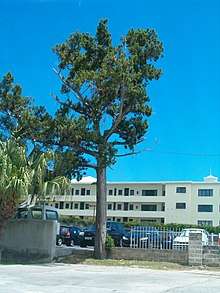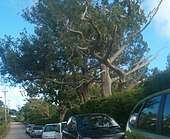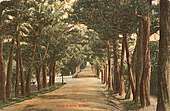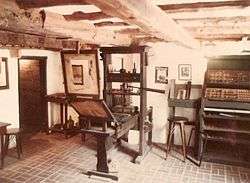Juniperus bermudiana
Juniperus bermudiana is a species of juniper endemic to Bermuda. This species is most commonly known as Bermuda cedar, but is also referred to as Bermuda juniper. Historically, this tree formed woodland that covered much of Bermuda. Settlers cleared part of the forest and the tree was used for many purposes including building construction and was especially prized for shipbuilding. However scale insects introduced during World War II devastated the forests, killing over 99% of the Bermuda cedar. Since then, the salt tolerant Casuarina equisetifolia has been planted as a replacement species, and a small number of Bermuda cedars have been found to be resistant to the scale insects. Populations of certain endemic birds which had co-evolved with the tree have plummeted as a result of its demise.
| Bermuda cedar | |
|---|---|
 | |
| Scientific classification | |
| Kingdom: | Plantae |
| Clade: | Tracheophytes |
| Division: | Pinophyta |
| Class: | Pinopsida |
| Order: | Pinales |
| Family: | Cupressaceae |
| Genus: | Juniperus |
| Species: | J. bermudiana |
| Binomial name | |
| Juniperus bermudiana | |
Description
The Bermuda cedar is an evergreen tree growing up to 15 m tall with a trunk up to 60 cm thick (larger specimens existed in the past) and thin bark that sheds in strips. The foliage is produced in blue-green sprays, with the individual shoots 1.3–1.6 mm wide, four-sided (quadriform) in section. The leaves are scale-like (1.5–2.5 mm long, up to 4 mm long on strong-growing shoots and 1-1.5 mm broad), with an inconspicuous gland. They are arranged in opposite decussate pairs, occasionally decussate whorls of three. Juvenile plants bear needle-like leaves 4–8 mm long. The cones are irregularly globose to broad pyriform (4–6 mm long and 5–8 mm broad), soft and berry-like, green at first, maturing bluish-purple about 8 months after pollination. They contain one or two (rarely three) seeds. The male cones are 4–6 mm long and begin yellow, turning brown after pollen release in early spring.
Ecology

A threat to the continued existence of Bermuda's cedars arose in the mid-1940s when the species was attacked by two species of scale insects, Lepidosaphes newsteadi and Carulaspis minima, which were unintentionally introduced from the United States' mainland during the wartime construction of US airbases in Bermuda. By 1978, these parasites had killed 99% of Bermuda's cedars, some 8 million trees. However, the remaining 1% of the trees proved somewhat resistant to the scale insects, and efforts by Bermuda's Department of Agriculture, Fisheries and Parks to propagate scale-resistant plants throughout Bermuda have helped in protecting the trees from extinction.
In the 1950s and 1960s Casuarina equisetifolia (also known as horsetail sheoak and Australian pine), native to Australia, was introduced into Bermuda to replace the Bermuda cedar's windbreak functions. C. equisetifolia have proven to be a somewhat competitive plant in Bermuda, this is due to casuarina leaf litter suppressing the germination and growth of understory plants by means of allelopathy. Similar to the Bermuda cedar, C. equisetifolia are resistant to wind and salt, features that have made C. equisetifolia a popular choice with gardeners in Bermuda. Other species introduced in an attempt to replace the cedar forest included the bay grape (Coccoloba uvifera). Along with C. equisetifolia, the Bermuda cedar's main introduced competitor for space is the Brazilian pepper (Schinus terebinthifolius).
The Bermuda cedar is occasionally grown as an ornamental tree outside of Bermuda, and may have become naturalised on Hawaii and Saint Helena. It is reported that more than 6,500 of them were planted in Hawaii between 1921 and 1953, and that it has established wild populations there.[2]
The Bermuda cedar forests that covered much of the Bermuda landscape, pre-deforestation, fed and housed many species of bird that had evolved and adapted to live amongst them. With the loss of so many trees, the populations of these bird species have declined to near extinction including the Bermuda white-eyed vireo, and a possible subspecies of eastern bluebird. Efforts by the public and the government have been made to boost their populations along with the populations of the Bermuda cedar. However the Bermuda cedar may take 200 years to reach full maturity, and the birds may not survive this long. With recent sea level rises, some low-lying old-growth cedars are being infiltrated with seawater and are beginning to die off.
Uses and history

It is known for its heavy, sweet aroma, useful and attractive reddish timber, significant role in Bermuda's history, and notable presence in Bermuda's historic homes.
When English settlers arrived in Bermuda, forests of Bermuda cedar flourished throughout the islands, and the species continued to thrive even as settlers developed the land. The timber was utilized by settlers due to its durability and workability, particularly in construction (homes, churches, jails, shipbuilding, interior woodworking, furniture construction, coffin-making) and export for sale. In addition, the cones were used by settlers as food for both themselves and their animals, and to prepare cedarberry syrup as a treatment for toothaches and coughs. Settlers also boiled the shoots in water to create an elixir for lowering fevers. Furthermore, the timber was found to repel moths and fleas as well as prevent mildew and rot, so many Bermuda residents used the wood to line closets and drawers.

The timber was especially prized by shipbuilders. It could be worked as soon as it was felled, and was naturally resistant to rot and woodworms. It was as strong as oak, but much lighter, contributing to the speed and maneuverability for which Bermudian ships were noted and prized. Its abundance enabled Bermudians to turn wholesale to a maritime economy after the dissolution of the Somers Isles Company in 1684.
In 1627, in an effort to conserve Bermuda's cedar forests, the local assembly passed legislation to restrict export of Bermuda cedar for shipbuilding. In addition, between 1693 and 1878, the Bermuda legislature passed sixteen further acts placing restrictions on the uses of Bermuda cedar. Despite these Acts, the shipbuilding industry eventually denuded much of Bermuda's landscape by the 1830s. Only the dawn of the age of steam-driven, steel-hulled ships allowed the forest to recover.
Many historic homes in Bermuda feature interior woodwork and furnishings made from Bermuda cedar. Examples of these homes include the Mayflower House, Camden House, Tucker House, and Verdmont House, the latter of which, according to the Bermuda National Trust, contains the colony's finest collection of antique Bermuda cedar furnishings. Because it is now both scarce, and expensive, and it is featured in many grand homes, its scent has come to be associated with wealth.
The Bermuda hedge fund Juniperus Capital is named after this species.[3]
References
- Wingate, D.B.; Adams, R. & Gardner, M. (2011). "Juniperus bermudiana". IUCN Red List of Threatened Species. 2011: e.T30376A9532928. doi:10.2305/IUCN.UK.2011-2.RLTS.T30376A9532928.en. Retrieved 5 August 2020.
- Little Jr., Elbert L. (1989). Common Forest Trees of Hawaii (Native and Introduced). U.S. Dept. of Agriculture, Forest Service. p. 321.
- "Origin of the Juniperus Name". Juniperus Capital. Retrieved January 17, 2011.
- Conifer Specialist Group (1998). "Juniperus bermudiana". IUCN Red List of Threatened Species. 1998. Retrieved 11 May 2006.CS1 maint: ref=harv (link) Listed as Critically Endangered (CR B1+2c v2.3)
- Adams, R. P. (2004). Junipers of the World: The genus Juniperus. Trafford Publishing ISBN 978-1-4120-4250-5
- Earle, Christopher J., ed. (2018). "Juniperus bermudiana". The Gymnosperm Database.
- Farjon, A. (2005). Monograph of Cupressaceae and Sciadopitys. Royal Botanic Gardens, Kew. ISBN 978-1-84246-068-9
- Bermuda Aquarium, Museum, & Zoo. Bermuda Biodiversity Project. Retrieved April 3, 2006.
- Forbes, Keith Archibald (2006). Bermuda's Flora. Bermuda Online. Retrieved April 3, 2006.
- Forbes, Keith Archibald (2006). Bermuda's Historic Houses. Bermuda Online. Retrieved April 3, 2006.
- Morisawa, TunyaLee (1999). Weed Notes: Juniperus bermudiana (pdf file). Retrieved April 3, 2006.
External links
| Wikimedia Commons has media related to Juniperus bermudiana. |
- Food & Agriculture Organisation of the United Nations: "The Bermuda Cedar". Gordon Groves, Director of Agriculture, Bermuda.
- Bermuda Government, Department of Conservation Services: "Species Profile – Bermuda Cedar".
